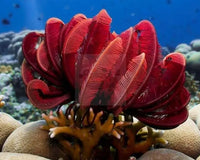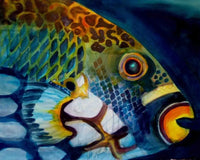Acanthuridae is a family of marine fishes that include surgeonfish, tangs and unicorn fish. These are among the most popular saltwater aquarium fish due to their beauty, generally non-offensive behaviour towards other fish species, and forgiving requirements. The name surgeonfish comes from the scalpel-sharp bony protrusion in each side of the base of the tail of these fish (the meaning of Acanthurus is Spiny-tail). Here are short profiles of some of the most popular Tangs and Surgeonfish, including scientific name, common names, distribution, maximum size, characteristics, compatibility, diet and feeding, minimum tank size, and reef tank suitability.
Achilles Tang
Achilles Tang (Acanthurus achilles) requires more care as one of the dominate of Tangs. It is highly susceptible to contracting Cryptocaryon protozoa and can have problems with HLLE. It can be aggressive towards other tangs, especially those of its own kind. These fish may need to be kept as the only tang in the tank. It naturally occurs in the tropical waters of the Pacific Ocean and grows up to 10 inches long. You will need a 120 gallon aquarium or larger for this beauty.
Convict Tangs
Convict Tangs (Acanthurus triostegus) also known as the Hawaiian Manini, are schooling fish and are found in the shallower oxygen-enriched waters of the Indo-Pacific reefs, where fine filamentous algae are abundant. This is in areas where there is little coral but has lots of rocks or stones that allow the algae to grow well with good sunlight exposure. They nibble the algae directly off the rocks. They are smaller tangs, growing to 8 inches and can be kept in 100 gallons or larger aquariums.
Goldrim Tang
Goldrim Tang (Acanthurus nigricans) is a very shy fish, but once acclimated to its surroundings it becomes very active. It is best kept alone. If you insist on having more than one of these fish, they should only be kept in a very large aquarium with ample cover, and not be kept with other more aggressive Acanthurus species. They are from the Pacific Ocean and grow to 8 inches in length.
Kole Tang
Kole Tang (Ctenochaetus strigosus) is a fantastic algae consumer. It also makes a good choice when it comes to compatibility with other more docile, non-related species. It only gets 6 inches long so can be kept in 70 gallon aquariums. It is from the Indo-Pacific region.
Because of its large size (up to 14 inches) and constant roaming nature, the minimum aquarium size suggested for the Orange Shoulder Tang (Acanthurus olivaceus) is 150 gallons. As long as the aquarium is large enough, a juvenile and an adult may be kept together. It is generally compatible with other non-aggressive tank mates, but if plans are to keep this species with other Surgeonfishes, it is recommended to add this fish first, or if of the same species, place them in the aquarium at the same time. It comes from the Indo-Pacific Ocean.
Naso Tang
Naso Tang (Naso lituratus) is a herbivore, with a preference for brown macroalgae. Some specimens may be reluctant to eat anything else, but for the most part, this species will usually accept the basic diet for Tangs & Surgeonfishes. On rare occasions, an individual may pick at large-polyp corals. It is a very large tang and grows to 18 inches in the Pacific Ocean, so will need a 300 gallon aquarium or larger.
Powder Blue Tang
Powder Blue Tang (Acanthurus leucosternon) is a very popular fish with aquarists, but one that is not easy to care for. It is highly susceptible to contracting Cryptocaryon and can have problems with HLLE. It can be aggressive toward other surgeonfishes, particularly those of the same shapes and colors. It grows to 9 inches long and needs a 90-gallon aquarium or larger. It is from the Indian Ocean.
Sailfin Tang
The Sailfin Tang (Zebrasoma veliferum) adjusts well to aquarium life, adapting easily to basic tank fed foods like flake food, shrimp, and nori (sheets of dried kelp), just to name a few. They will eat just about anything, but being more of a herbivore, they prefer greens. They come from the Indo-Pacific areas and grow up to 15 inches long, so need 150 gallons or larger aquariums.
YELLOW TANG
The popular Yellow Tang (Zebrasoma flavescens) is a herbivore, grazing on algae and other plant life. It is best kept in an aquarium that has good algae growth, where in turn they earn their keep by helping to keep the algae growth cropped. It will feed on nori (dried or roasted seaweed), other green vegetable matter, and vitamin-enriched flakes, but may nibble at dried shrimp and other meaty fares as well. They grow to 8 inches in length. They are found around the Hawaiian islands.





